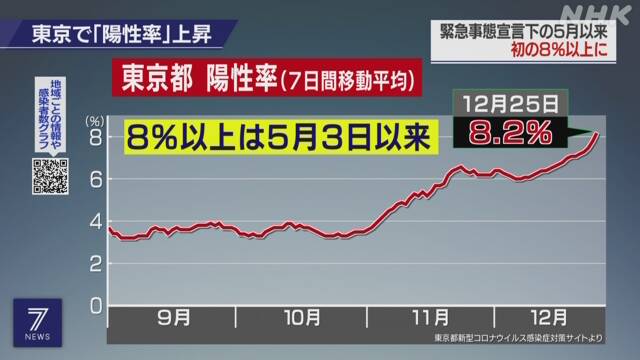In Tokyo, the percentage of people who have been tested positive is rising, reaching 8.2% as of the 25th, the highest since the state of emergency was lifted in May. It became expensive.
The Tokyo Metropolitan Government publishes the "positive rate" as the number obtained by dividing the average of those who were found to be positive in the week up to the previous day by the average of those who tested in the week up to the previous day.
The positive rate as of 25th, announced on 26th, was 8.2%, the highest since the state of emergency was lifted on May 25th.
It has been above 8% since May 3, when the state of emergency was declared.
The positive rate in Tokyo was in the 3% range from September to October, but rose to 6% in the middle of last month.
And it was 7.0% on the 18th of this month, and it has been increasing since then.
The highest positive rate in Tokyo so far was 31.7% on April 11, when a state of emergency was declared, and in April the number of tests was significantly lower than it is now, and more than half of the days are 20% to 30. It was in the% range.
Expert "Increasing positive rate may continue"
Regarding the fact that the "positive rate" continues to rise in Tokyo, Professor Kazuhiro Tate of Toho University, the chairman of the Japan Society for Infectious Diseases, said, "In the first wave of infection, the testing ability was lower than it is now, and the number of tests The positive rate was high even though there were few, but now the positive rate is rising as it is possible to test much more. Tokyo has a particularly high population density and many people come and go. There are many restaurants with a high risk of infection, and the infection may have spread to all parts of the city. Consider that there may be many people who are infected in addition to those who are positive. I have to. "
On top of that, Professor Tateda said, "Given that people's behaviors and countermeasures have not changed much, we must consider that the tendency for the positive rate to rise may continue in the future. In order to proceed, it is important to firmly control the infection situation in the metropolitan area including Tokyo. While the number of newly infected people is renewing the highest number, when the year-end and New Year holidays are reached, the number of infected people will increase further at the beginning of the year. As a result, the collapse of medical care becomes more realistic, so it is necessary to spend the year-end and New Year holidays as quietly as possible, such as by carefully deciding to return home and refraining from meetings that involve eating and drinking. "

